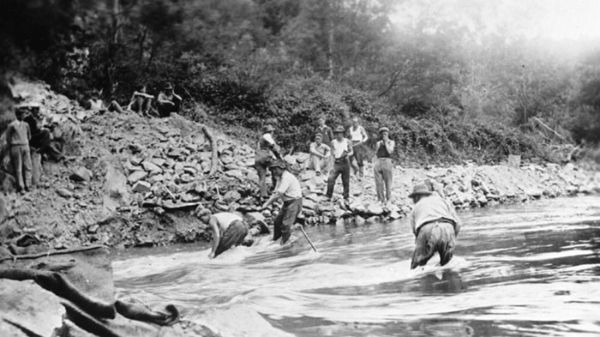
There are many lost treasures in Michigan. These hidden treasure tales have been passed down through generations, so some elements of the lost treasure stories might have been altered here and there, but the fact remains that there are many treasures buried in Michigan that remain to be found.
So pick up your metal detector and head out to begin your search for these valuable lost treasures.
Quick Recommendation for treasure hunters: There are so many ways and tools that can help you find treasures. The tool that I actually recommend is using a Metal Detector. Indeed, while there so many expensive models out there costing 1000s of dollars, I still recommend using a mid-level machine that should not cost you that much. In fact, if you don’t have a big budget, I recommend using this quality metal detector that should be affordable for most average hobbyists out there. It has more than enough features you will need to find most treasures buried in the ground.
Without further ado, here are some of the most popular tales of lost treasures in Michigan …
1. Douglas Houghton’s Lost Gold Mine

One of the most famous stories of lost treasures in Michigan is that of Douglas Houghton’s lost gold mine.
Douglas Houghton was the first state geologist of Michigan. He carried out many geological surveys in the Keweenaw Peninsula in 1831 and 1832 and concluded that there was evidence of valuable copper ore in that area.
On one such geological survey, Houghton is reported to have found a specimen of gold ore. He only shared his discovery with Samuel Worth Hill. At that time, Houghton was working in the Log Lake area near Champion in Michigan.
However, when Houghton left the area after completing all his fieldwork, he never made it back alive.
His boat overturned in a storm on Lake Superior, and Houghton and a few other men drowned near Eagle River in October 1845. With him, the location of where he got his gold ore from was lost forever.
2. Lost Gold Mine near Black River
In 1912, several gold nuggets were found on the farm belonging to Mr. Fleming in Harrisville in Michigan. Several men were digging a mine shaft, but due to an explosion of their steam equipment, the mining work had to be stopped.
So this gold mine was abandoned, and no one proceeded with the exploration after that. It is believed that this lost gold mine is located in the northwest cover of section 8 in the Haynes Township near Black River.
3. Lost Treasure on Drummond Island

Located near the border of Canada, Drummond Island was occupied by the British during the Revolutionary War all the way till the war came to an end in 1812.
There are many ruins of building from the 17th and 18th centuries that are located on this island even today. It is believed that there are a couple of buried treasures on Drummond Island.
The first story about buried treasure here is about a French fur trader who opened a trading post in 1750. His family, though, found that he started becoming mentally unwell, and it is said that one day soon after, he filled a pot of gold coins and buried it somewhere in the woods located near the trading post.
When his family questioned him about the missing gold, he did not tell them where he hid it. As the story goes, this missing gold was never recovered and still remains buried on Drummond Island itself.
Another legend states that on the southwestern side of the island, located near Lake Huron, there is a large cache of buried Spanish silver and gold coins.
Another legend says that when British General Monk was fleeing from Drummond Island in 1812, he buried the British Army payroll inside an iron chest and buried it on the southwest tip of Drummond Island.
Yet another story states that there is $50,000 in gold coins buried on the northwestern side of Drummond Island near the Potagannissing Bay. Drummond Island can turn out to be worth billions if these treasure stories turn out to be true.
4. Treasure of the Sunken Steamer SS Chicora
The SS Chicora was a passenger steamer that sank in Lake Michigan on January 21, 1895. All onboard the steamer lost their lives.
It is reported that after the sinking of the steamer, many gold coins, and whiskey bottles washed ashore during storms on Bridgman Beach, which is located near the town of St. Joseph in Michigan.
It is believed that these valuable coins belonged to the wreck of the SS Chicora as it was known that she was carrying whiskey bottles, silver ingots, and around $50,000 in gold coins at the time of the sinking. Over the years, several pieces of wreckage have been recovered, but most of the gold coins still remain sunken at the bottom of Lake Michigan.
A little while after the sinking, bottles with notes in them were found that were written by the crew members as the ship was going down.
An eerie fact about Lake Michigan is that over 1500 ships have sunk in her waters. With this huge number, can you possibly imagine all the treasure that remains unclaimed and unfound at the bottom of Lake Michigan? If you have an underwater metal detector, Lake Michigan is a prime spot in Michigan to search for lost treasure.
5. Buried Stagecoach Loot at the Shore of Benton Lake

In August 1874, a gang of bandits robbed a stagecoach that was carrying $74,000 in gold. The gold was being sent to a huge lumber camp located near Lake Benton. The gold was intended to be used as a payment to the loggers there.
The robbers got away with the gold, but they knew that people from the lumber camp would come looking for them. So they decided to bury the loot inside a cast-iron stove they had, dug a hole, and buried the stove containing the gold between two tree stumps on the northern shore of Benton Lake. Lake Benton is located south of Baldwin in Michigan.
If the stove is still buried there, it would easily be worth over half a million dollars today.
6. Lost gold bullion in Lake Michigan

As mentioned above, Lake Michigan is home to many sunken ships. Stories state that a ship whose name has gotten lost over the years sunk off the shores of Poverty Island in Lake Michigan.
This was during the Civil War, and the ship was said to be carrying around $4.5 to $30 million in gold bullion at the time of the sinking.
Some stories also say that the gold came from England via Canada and was on its way to the Mississippi River through Lake Michigan to help fund the Confederate cause in the war.
The Union Army is said to have found out about the valuable gold on the ship, and they attacked it. The ship is said to have sunk off of Escanaba in Lake Michigan along with the valuable gold bullion cargo.
Although there is no name given to this particular ship, a mention of this can be found in the lists of the Great Lake Shipwrecks.
7. Lost Indian Gold Mine
Stories state that there is a lost Indian gold mine somewhere in the upper peninsula of Michigan in Porcupine Mountain State Park, which is located near Silver City.
The legend says that when the first European settlers arrived in this region, they found the Indians wearing jewelry made up of gold nuggets.
The Indians also used to trade a lot of gold with the settlers. This lost mine is said to be located somewhere in Porcupine Mountain State Park, so if you want to metal detect in the park, remember that you need to get permission before detecting.
8. Jack Driscoll’s Lost Gold Mine
In the 1800s, Jack Driscoll was known to be a wild man who spent most of his time drinking, gambling, and fighting in the town of Seney in Michigan.
There are many stories of Jack Driscoll’s wayward ways were known far and wide. It is said that ultimately when Driscoll ran out of money to pay for his drinking and gambling, he was found to often head out to the Huron Mountains, located in the northern direction from Seney.
The townsfolk eventually tried to track him but would always end up losing sight of him because this part of the country was very wild and remote.
Driscoll would always come back with gold nuggets and sometimes silver as well. Again once he would use up all that money, he would go back out again and come back with more gold and silver.
However, Driscoll never divulged the source of his gold and silver, and it is assumed that he found a secret gold mine hidden somewhere in the Huron Mountains.
It is believed that the mine might be located near the mouth of the Yellowdog River.
9. Treasure on North Fox Island

Located off the Grand Traverse Bay, North Fox Island was the scene of a grand recovery of a buried cache in 1905. The treasure was worth around $100,000 and consisted of Spanish gold and silver coins.
There are many stories that there are many more treasures buried here.
10. Treasure on Cat Head Point
Located near Northport on county route 201, Cat Head Point is believed to be home to many treasures that were buried by robbers after the Great Chicago Fire in 1871.
The stolen money was taken from several banks, and it was never found.
11. Henry Dansman Treasure
The Henry Dansman treasure is believed to be located between the village of Posen and Lake August on county route 65.
Denman was a wealthy farmer who apparently buried a huge cache of gold and silver coins and diamonds on his property. Many treasure hunters have tried their luck, but the treasure still remains lost.
12. Mack Island and the Buried Bank Loot
On July 29, 1920, four men robbed the Farmer’s State Bank in Grass Lake in Michigan. They tied up the employees and customers with fishing lines and stole nearly $69,000 in the currency as well as $1300 in gold and silver coins.
The robbers jumped into their getaway car and sped off towards Mack Island. Once word got out of the robbery, Sheriff Worden from Jackson County believed that these thieves were fishermen who lived at Wolf Lake on Mack Island.
Sheriff Worden and deputy Verl Kutt reached the island and noticed that a known criminal named Ted Harris was living in a house there.
Upon asking for permission to search the house, a gunfight broke out, and the thieves were found to be inside Harris’ house itself. They shot and killed the sheriff and wounded deputy Kutt.
While three of the thieves, including Harris, escaped into the swamps, and the others were captured. All six men were eventually arrested and tried.
The gang returned the $69,851 they stole from the bank, but they never returned the $1300 worth of gold and silver coins. It is believed that these gold and silver coins are still buried somewhere on Mack Island near Harris’ hideout.
13. The Steamship Superior and its lost treasure
The Steamship Superior was a ship that sank off the shores of Grand Island in Lake Superior on October 29, 1856. The ship was on its way to a mining town in northern Michigan when it got caught up in a horrible storm and sunk.
At the time of sinking, the ship was carrying $30,000 in $20 gold double eagles that were kept in 15 canvas bags in a safe on board. Today somewhere in the waters off Grand Island in Lake Superior, there lies the wreck of the Steamer Superior and her valuable treasure.
14. The Many Treasures Buried by Outlaw Doty
Doty was an infamous outlaw who operated in the 1800s throughout the states of Michigan and Indiana. He is known to have spent a lot of time in jail in Michigan, Ohio, and Indiana.
When he was not inside prison, he was known to spend his time stealing horses and cattle. He is also said to have killed five to six people, though he was never convicted for these crimes.
During the Civil War, Doty was a gang leader, and together with his gang, he stole from many general stores that collected a lot of money for the gang over the years.
However, when authorities did catch him, he never had more than a couple of silver dollars on him, giving rise to speculation that he was hiding his money somewhere.
Doty had a habit of hiding out on farms, from where he would go to swampy areas in Steuben County near Angola and Frempon in Michigan. He is also known to stay near Coldwater and Hillsdale.
Doty is said to have buried a small amount of $100 to $1000 in gold and silver coins in various places where he stayed and near the swamps in Steuben County.
Over the years, people have discovered three of his caches, worth to be around $1700 in gold and silver coins. There are many more such caches belonging to Doty that are buried at many places on farms and swampy areas of Steuben County.
15. Treasure in the Kalamazoo River
Even though there never was a gold rush in Michigan similar to California, Alaska, or the Yukon, this does not mean that gold is not there in the rivers and streams of Michigan.
A 1906 geological survey of Michigan carried out by the state found dozens of places where gold could be found, including the streams near Allegan. Similar traces of gold were also found near Marcellus in Cass County and Buss Oak in St. Joseph County.
Final Thoughts
Hopefully those lost treasures in the state of Michigan got you excited to start your own adventure to hunt for treasures yourself, whether in Michigan or any other state.
If you are aware of any other lost treasure in Michigan or you’ve got any story you want to share, let me know so I can feature it in this article.
